The dose-response effect of medical exercise therapy on impairment in patients with unilateral longstanding subacromial pain
- PMID: 20148093
- PMCID: PMC2817873
- DOI: 10.2174/1874325001004010001
The dose-response effect of medical exercise therapy on impairment in patients with unilateral longstanding subacromial pain
Abstract
Objectives: The primary aim of this study was to investigate the effect of medical exercise therapy in shoulder impingement patients, along with possible correlations between impairment variables.
Study design: A prospective unblended randomized clinical trial.
Methods: Over four months, 61 participants were randomly assigned into a high-graded exercise therapy group (HD) (n=31) and into a low-graded exercise therapy group (LD) (n=30). Prognostic variables were similar between the groups at baseline. Five (8%) patients dropped out during the treatment period, and another four (6%) dropped out before followup. Pain was a composite score of a visual analogue scale (VAS). Isometric strength was measured during four resisted break tests on the shoulder. Function was measured by means of a functional assessment questionnaire (Shoulder Rating Questionnaire, SRQ). Both groups trained three times per week for twelve weeks, with tests pre- and posttraining and six months follow-up.
Results: The HD group achieved significantly (p < 0.05) better outcome effects than the LD group for pain, range of motion, isometric functional strength and function, but both groups increased function from pretest to posttest.
Conclusions: In patients with uncomplicated subacromial pain syndrome, medical exercise therapy is an efficient treatment alternative, where high-grade doses should be emphasized. A major limitation is that the measurements were not undertaken by another person than the treating physiotherapists.
Keywords: Shoulder; dose-response; impingement; muscle function.; physical therapy; rehabilitation.
Similar articles
-
Comparison of supervised exercise with and without manual physical therapy for patients with shoulder impingement syndrome.J Orthop Sports Phys Ther. 2000 Mar;30(3):126-37. doi: 10.2519/jospt.2000.30.3.126. J Orthop Sports Phys Ther. 2000. PMID: 10721508 Clinical Trial.
-
Neurocognitive therapeutic exercise improves pain and function in patients with shoulder impingement syndrome: a single-blind randomized controlled clinical trial.Eur J Phys Rehabil Med. 2014 Jun;50(3):255-64. Epub 2014 Jan 16. Eur J Phys Rehabil Med. 2014. PMID: 24429918 Clinical Trial.
-
Exercise therapy after ultrasound-guided corticosteroid injections in patients with subacromial pain syndrome: a randomized controlled trial.Arthritis Res Ther. 2016 Jun 4;18(1):129. doi: 10.1186/s13075-016-1002-5. Arthritis Res Ther. 2016. PMID: 27262892 Free PMC article. Clinical Trial.
-
Pain, motion and function comparison of two exercise protocols for the rotator cuff and scapular stabilizers in patients with subacromial syndrome.J Hand Ther. 2018 Apr-Jun;31(2):227-237. doi: 10.1016/j.jht.2017.11.041. Epub 2018 Jan 10. J Hand Ther. 2018. PMID: 29329890 Clinical Trial.
-
Effects of eccentric exercise in patients with subacromial impingement syndrome: a systematic review and meta-analysis.BMC Musculoskelet Disord. 2019 Oct 14;20(1):446. doi: 10.1186/s12891-019-2796-5. BMC Musculoskelet Disord. 2019. PMID: 31610787 Free PMC article.
Cited by
-
Adherence Tracking With Smart Watches for Shoulder Physiotherapy in Rotator Cuff Pathology: Protocol for a Longitudinal Cohort Study.JMIR Res Protoc. 2020 Jul 5;9(7):e17841. doi: 10.2196/17841. JMIR Res Protoc. 2020. PMID: 32623366 Free PMC article.
-
Efficacy of exercise therapy in workers with rotator cuff tendinopathy: a systematic review.J Occup Health. 2016 Sep 30;58(5):389-403. doi: 10.1539/joh.15-0103-RA. Epub 2016 Aug 4. J Occup Health. 2016. PMID: 27488037 Free PMC article.
-
Manual therapy and exercise for rotator cuff disease.Cochrane Database Syst Rev. 2016 Jun 10;2016(6):CD012224. doi: 10.1002/14651858.CD012224. Cochrane Database Syst Rev. 2016. PMID: 27283590 Free PMC article.
-
How does exercise dose affect patients with long-term osteoarthritis of the knee? A study protocol of a randomised controlled trial in Sweden and Norway: the SWENOR Study.BMJ Open. 2018 May 5;8(5):e018471. doi: 10.1136/bmjopen-2017-018471. BMJ Open. 2018. PMID: 29730615 Free PMC article.
-
Inter-rater Reliability of Sustained Aberrant Movement Patterns as a Clinical Assessment of Muscular Fatigue.Open Orthop J. 2016 May 27;10:125-34. doi: 10.2174/1874325001610010125. eCollection 2016. Open Orthop J. 2016. PMID: 27347241 Free PMC article.
References
-
- Jette AM, Delitto A. Physical therapy treatment choices for musculoskeletal impairments. Phys Ther. 1997;77:145–54. - PubMed
-
- Luime JJ, Koes BW, Hendriksen IJ, et al. Prevalence and incidence of shoulder pain in the general population; A systematic review. Scand J Rheumatol. 2004;33(2):73–81. - PubMed
-
- Kuhn JE. Exercise in the treatment of rotator cuff impingement: A systematic review and synthesized evidence-based rehabilitation protocol. J Shoulder Elbow Surg. 2009;18:138–60. - PubMed
-
- Desmeules F, Cote CH, Fremont P. Therapeutic exercise and orthopedic manual therapy for impingement syndrome: a systematic review. Clin J Sport Med. 2003;13:176–82. - PubMed
LinkOut - more resources
Full Text Sources
Medical
Research Materials

